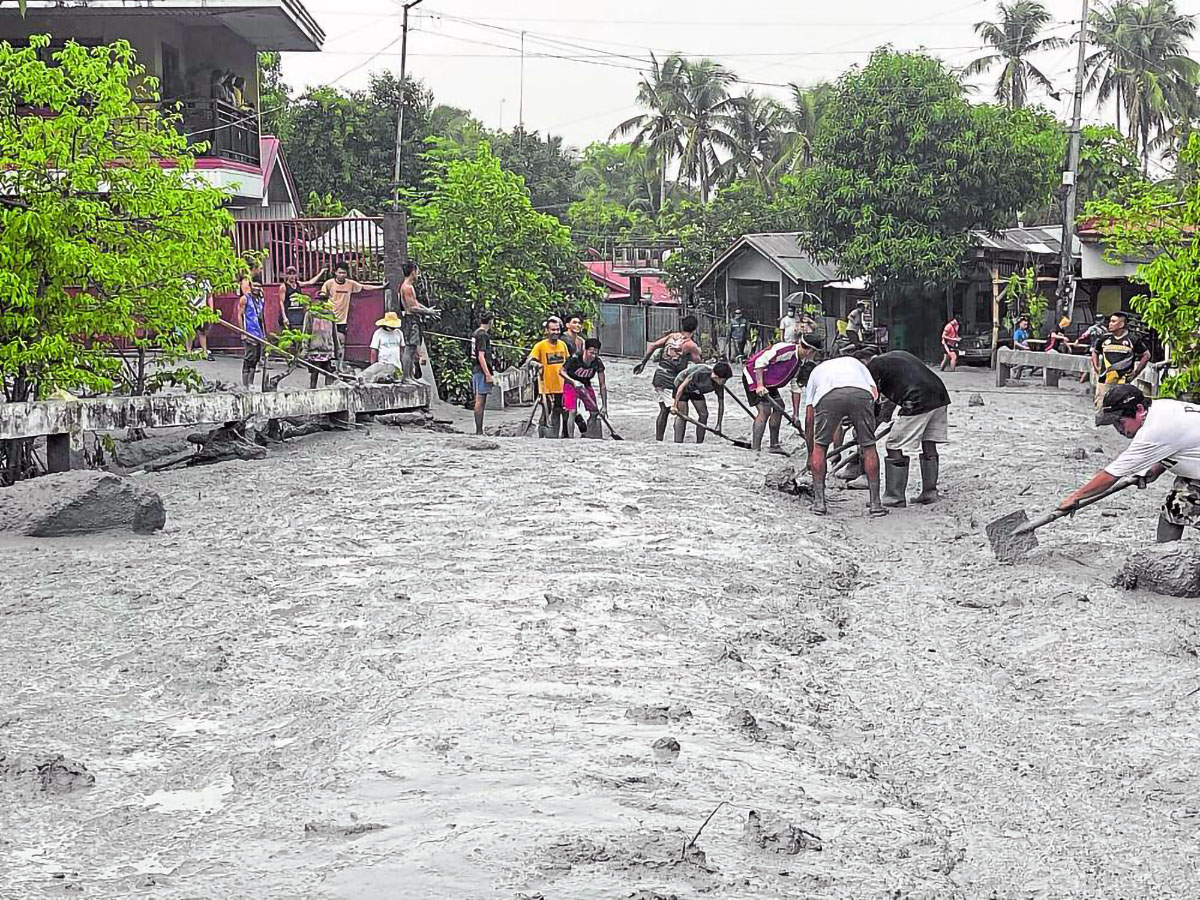
COMMUNITY ACTION Residents of Barangay Biak na Bato in La Castellana, Negros Occidental, on Wednesday work together to clear lahar that covered the village’s roads and blocked the flow of traffic. Lahar flowed through the village’s streams and rivers after rains washed out the volcanic debris, including ash from Mt. Kanlaon’s eruption on Monday night. —Contributed photo
BACOLOD CITY, NEGROS OCCIDENTAL, Philippines — A thick mudflow following Monday’s eruption of Mt. Kanlaon has isolated several communities in La Castellana town, Negros Occidental, and forced residents to evacuate, local officials said on Wednesday.
The Philippine Institute of Volcanology and Seismology (Phivolcs) said several sitios (subvillages) in Barangay Biak na Bato, at the foot of the volcano, were hit by lahar, a grayish mudflow composed of ash and other debris from the eruption that were washed out by rains.
The heavy lahar flow blocked the highway in Barangay Biak na Bato on Wednesday afternoon.
READ: Kanlaon quiet after night of rumbling, rain of rocks
La Castellana Mayor Rhummyla Mangilmutan said residents in six sitios in Barangay Biak na Bato and another sitio in Barangay Masulog were being evacuated because heavy rains would only cause more lahar flow, making it more difficult to rescue them.
“There is already lahar flow on the Biak na Bato highway so we are evacuating now before it becomes totally impassable,” she said.
Lahar was also reported in Barangay Cabacungan, also in La Castellana, as well as in the town’s water channels.
Mari-Andylene Quintia of the Phivolcs Kanlaon Observation Station in La Carlota City said lahar was caused by strong rain that washed out the volcanic debris, including ash from Monday’s eruption.
It breached streams, creeks, rivers and canals and spilled onto roads.
Negros Occidental Gov. Eugenio Jose Lacson said that while the volcano appeared to have calmed down since its eruption on Monday night, residents had been asked to remain in evacuation centers while alert level 2 (moderate level of volcanic unrest) was still up.
Gov’t assistance
The Department of Social Welfare and Development (DSWD) on Wednesday said it had extended more than P758,000 worth of humanitarian aid and created gender-sensitive spaces for thousands displaced by the eruption of Mt. Kanlaon.
Of the total assistance given so far, P611,980 went to those affected in Negros Occidental province, and another P146,090 for those in Negros Oriental, DSWD spokesperson Irene Dumlao said.
The aid was given in the form of family food packs containing rice, canned goods and packets of instant coffee. Nonfood items, such as hygiene, clothing, sleeping and kitchen kits, were also distributed to evacuees.
According to a report by the Disaster Response Operations Management, Information and Communication, the DSWD, including its field offices, has standby funds and relief stockpile amounting to P2.8 billion.
Dumlao said psychosocial intervention had also been given to children and teens taking shelter at La Castellana Elementary School to “prioritize the well-being” of affected minors in the wake of the eruption.
Based on the DSWD’s monitoring, more than 420 families, or 1,400 people, have been staying in 11 evacuation centers in Negros Occidental and Negros Oriental.
“Due to the heightened vulnerability of children during disasters … child-friendly and women-friendly spaces were set up to enhance their resilience against the negative effects of emergency situations on their well-being,” Dumlao said in a statement.
Meanwhile, the Civil Aviation Authority of the Philippines on Wednesday extended the Notice to Airmen (Notam) for flights near Mt. Kanlaon with vertical limits from the surface up to 5,181.6 meters (17,000 feet).
The latest Notam will be effective from June 5 to 9 a.m. of June 6.
The Notam “strongly advised” flight operators to avoid flying close to the volcano’s summit due to the potential for sudden and hazardous steam-driven or phreatic eruptions, which may pose a hazard to aircraft. —with reports from Kathleen de Villa and Jerome Aning